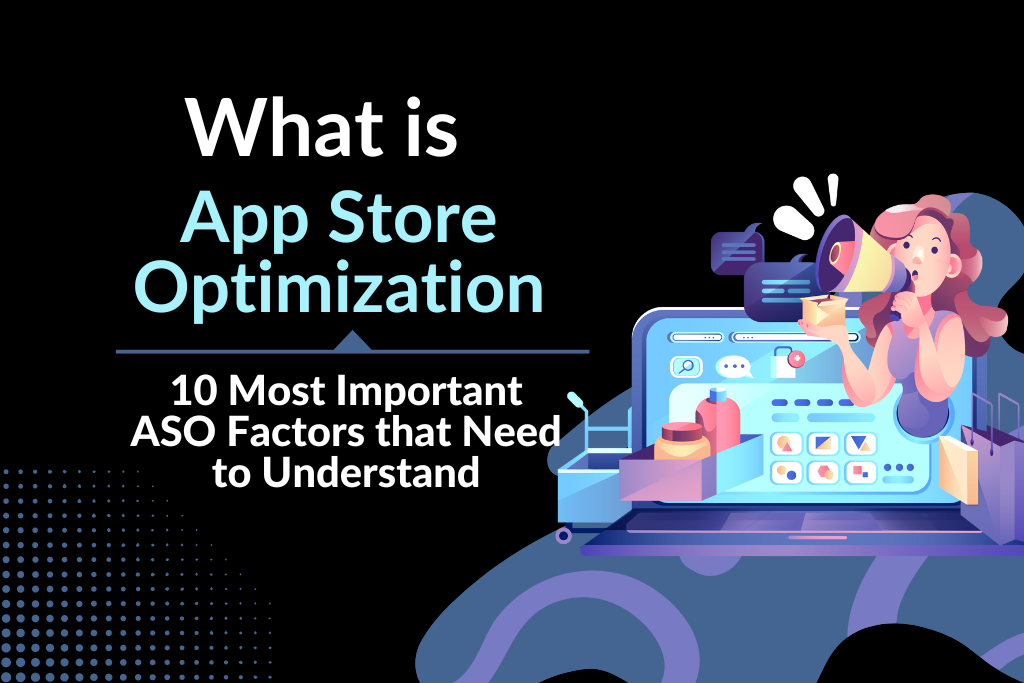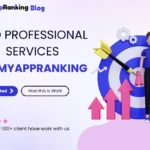What is App Store Optimization? The In-Depth Guide for 2024

What is App Store Optimization
In recent days, it has become more challenging for app publishers and developers to discover the app in the major app stores‘ search results from more than 6 million mobile apps.
This number is increasing day by day due to the billions of smartphone users & more than 6 million mobile apps in the app store and these are enormous staggering numbers if you want your app to get noticed in this tough competition.
If you want to beat this competition and want more installs, top ranking, a higher number of conversions & engagement, user acquisitions, and boost visibility then definitely you will need to understand the App Store Optimization ASO and its importance for the mobile app ranking & visibility.
What is App Store Optimization?
App Store Optimization (ASO) is the process of improving the visibility of mobile apps in the Google play Store or Apple App Store and increasing the app ranking to get more installs.
The main goal of the ASO is to improve the app ranking, so it can visible to more potential customers and get a higher number of app downloads. What is Optimizing Apps? It involves optimizing the different elements of the app including the title, description, icons, keywords, and graphics to increase its visibility and make it discoverable in the app store search results when any user searches for these types of specific apps.
Why ASO is important?
According to Google, 55% to 65% of apps search through the app store search results. This is one of the most discoverable channels for searching the new apps and downloading them. If you are ignoring the ASO and don’t know the Benefits of App Store Optimization, then you are missing the big discoverable channels for your apps and games on the Google Play Store and the Apple App Store.
It can help to increase the number of users who discover and download the app from app store search results, which can convert the users to increased app revenue, brand exposure, and more leads. Some of the key factors that can directly impact the app’s visibility in the app store include the relevancy of the app to the search terms used by users, the quality of the app, and the overall user experience.
10 Most Important ASO Factors and App Store Optimization Best Practices that Need to Understand:
Here are the most important ASO factors which really help the app optimization to rank in the top position, more visibility, a higher number of installs, and leads. There are millions of apps in the app store which are trying to rank above one another, the most crucial is to understand the ASO and how the ASO factors can help the publisher to beat this competition.
1): Keywords Searching and Analysis:
It is one of the most important factors in ASO optimization. Mobile app ranking, visibility, and installation totally depend on the keywords. Here are a few tips and methods which need to understand when doing keyword searching for the app.
Use Relevant Keywords:
Keywords are the core element in the ASO process for the top app ranking. Google Play Store and Apple App Store rank the content on the basis of relevancy. Customers discover the app through different search queries and keywords. In this step, there need to understand the different queries and potential customers who are using different keywords to find the apps. When you will understand which keywords are relevant according to these queries then you will able to reach out to the more targeted potential customers which will give more conversions, top ranking, and brand exposure.
Finding the Top Competitors Keywords List:
Top competitors’ keywords list means the list of those keywords on which top competitor’s apps are ranking in the search results, as well as the keywords your top competitors are targeting. Here are the different app store optimization tools that use to find the top competitors’ keywords list like AppAnnie and Sensortower etc.
Brainstorming Strategy – Choosing Keywords:
The main goal in brainstorming is to come up with many search terms as can be used for your products at the Google Play Store or Apple App Store. These are specific words or phrases that relate to your main idea or niche that your ideal customers may be searching for.
Using the Long Tail Keywords List:
Long tail keywords are those search terms with relatively low search volume and competition. You can get 2 benefits from these long tail keywords list including the high conversion rate for the app and can easily rank in the top position for these words.
Finalizing the Keywords List:
Finalizing the keywords list based on the user intent, low competitive keywords, and long tail keywords list. This keyword and App Store Optimization Strategy will be very helpful for the highly competitive app when it is a tough task for the marketer to rank in the top positions.
2): App Title Optimization:
It is one of the most important metadata which has a 10% weightage to increase the app ranking and get more downloads. Here need to add the more important seed keyword with the company name which can easily represent your app, understandable for the user to get the installation.
The app title is also the first metadata that the user will see on the search listing and here need to insert the keywords naturally which should be engaging for a higher number of conversions.
For the Google Play Store and App Store, there is a limitation of 30 characters. Here you can see examples of the app which include both the primary keyword and the Brand Name.

Here are some tips to optimize the app title:
1): Keep it short and concise: The app title should be no more than 30 characters long and should clearly convey the main purpose and functionality of the app.
2): Include keywords: Select keywords that are primary keywords for the app and highly searchable in the search store. These keywords should add to the title in a readable way.
3): Unique App Title: The title should be unique and different from similar apps in the app store.
4): Capitalize the first letter: Capitalize the first letter of each word in the title to make it easier to read.
5): Avoid using special characters: Avoid characters like emojis etc which have no importance in the searchable result in the app store instead use the the more relevant words to the app characteristics.
3): Short Description Optimization:
The short description is also an important ASO Metadata element that directly impacts the app ranking, installation, and conversion rate. It is only available on the Google Play Console Listing and not on the IOS app store.
Google Play console allows publishers to include up to 80 characters for a short description. The best way to optimize the app’s short description is to highlight the all best things about your app, and the core keywords.
4): Subtitle Optimization:
The subtitle is another option for the IOS app publisher to add a creative subtitle with more descriptive keywords to grab the user’s attention and a higher number of downloads. It also has a 30-character limit.

5): IOS Keyword Field:
The keywords field is the core element for the Apple App Store Optimization. IOS App Store also gives the facility the publisher to add a 100-character list separated by commas. It is one of the best sources to get discovered through app store searches and related content.
Here are a few tips on when to use the keyword in the app store keyword field
- Stop words such as too, for, and you, to, etc. It will only waste the character limit and not be helpful for the ranking
- Don’t use those keywords which have already been used in the app name and subtitle
- Don’t use the space between the words, which is only a waste of the character limit
- Use both singulars and plurals. Both singular and plural have different results and use for the best results.
6): App Description Optimization:
The app description is the most important part of the store optimization for the apps because it helps the publishers to explain the app, what the app does, and why they should download it. A well defines and informative app description can convince users to install the app and also improve the app’s visibility in the app store.
For the Google Play Store, the app description is indexable by the search algorithms and if we add the keywords in the app description then it will help for higher ranking, visibility, and conversions.
Note: IOS app store algorithms ignore the app description but we can explain it well in the first 250 characters to convince the users to download it.
Here are some tips that should be followed to optimize the Play Store app description.
- Include keywords in the app description: Use the secondary, long tail, and medium frequency keywords in the app description. The benefit of using the long tail keywords even if they have less search traffic but have a high conversion rate which gradually gets more traffic on the app and finds new potential customers. These keywords should be used naturally and not be stuffed into the description. The most important and primary keywords should be added in the first 180 characters rather than in the middle or end of the app description. It will be very helpful for instant ranking and more conversion values.
- Frequency of keywords: Repetition of keywords can increase your app’s position in the search ranking. For good results, a keyword can repeat 3 to 5 times for the 4000 characters but make sure that the description should be readable and use them naturally.
- Analyze the competitor’s keywords: For the best results and to find the right app store optimization keywords for the app, you should analyze the competitor’s keywords that are used in the app description and metadata.
- Format of the App Description: To format the app description effectively, employ bullet points, paragraphs, and emojis. This enables users to swiftly grasp the key features of the app.
- Highlight unique features of the App: Ensure to emphasize all distinctive attributes of the app that set it apart from similar offerings in the store.
- Include contact information: Incorporate contact information within the app description if you desire users to easily reach out to you for support or provide feedback.
7): App Ratings and Reviews
App ratings and reviews are important factors because they can help to improve app ranking and also influence a user’s decision to install the app.
Positive ratings and reviews can help to build credibility with potential users, which can increase the chances that they will download the app. Bad ratings and reviews, on the other hand, can discourage users from installing the app and can directly impact the app’s ranking and visibility.
To encourage users to leave positive reviews and ratings, it’s important to create a high-quality app that meets the user’s needs and expectations. You can also ask users to leave ratings and reviews within the app or in emails or other communication channels.
It’s also a good idea to respond to all reviews, both positive and negative, in a timely and professional manner. This can show users that you value their feedback and are committed to improving the app.
8): Localization of the App
Localize your app in specific languages to make it more appealing to users in different countries and can increase the app’s visibility and user engagement in those specific countries. This will include localizing the all-important metadata elements which can affect the app visibility and ranking.
Localizing the app in different languages will easy to access the global market, have a higher conversion rate, and competitive advantage, and improve overall ranking, and top keyword ranking on local keywords.
To localize an app, you will need to translate the app’s text and user interface into the target languages. It’s important to use professional translation services to ensure that the translations are accurate and of high quality.
Once the app has been localized, it’s important to test it thoroughly to ensure that it’s functioning word properly and is easy to use in the target languages. You should also consider localizing the app’s marketing materials, such as the app store listing and website, to further appeal to users in the target market.
9): App Icons and Screenshots:
App icons and screenshots play a vital role in optimizing an app store presence as they offer users a visual glimpse of the app and can sway their choice to download it. They should be visually attractive, uncomplicated, and aligned with the app’s purpose.
Utilizing screenshots and other graphical elements like promotional videos and feature graphic images can improve users’ comprehension of the app’s functionality and visual appearance. Incorporating high-quality and visually appealing screenshots can effectively persuade users to download the app.
It’s important to carefully design the app icons, screenshots, and other graphics to ensure that they accurately represent the app and appeal to users for the installation.
10): Number of App Downloads
The number of app downloads is an important part because it represents the app’s popularity in the search results and user engagement with it. The high number of app installs can grow the app’s ranking and visibility in the app store which can turn into more leads.
Several factors can influence the number of downloads including the app’s visibility, app quality, functionality, and the marketing efforts used to promote the app.
To increase the number of app installs, it is very important to optimize the app in all on-page and off-page metadata including the app title, subtitle, short description, and long description, getting positive reviews & ratings, and ensuring the app is high quality that meets all user requirements.
In conclusion, App Store Optimization (ASO) is one of the best sources to increase app discoverability in search results and improve app ranking and visibility to drive it for more downloads. By optimizing all elements of an app listing including the title, connecting keywords list, description, and custom listing, we can make the app easily discoverable in the search store and reach the target audience for the app installs.
Do you Want
More App Downloads?
Boost the Mobile App Growth with the Ultimate Mobile App Marketing Experts
Latest Blogs
Categories
Do you Want
More App Downloads?
Boost the Mobile App Growth with the Ultimate Mobile App Marketing Experts
App Store Optimization is the process of optimizing a mobile application’s presence on app stores to enhance visibility, attract users, and improve conversion rates. It involves various strategies like keyword optimization, visual enhancements, and more to increase an app’s chances of being discovered by potential users.
ASO is crucial because it improves an app’s visibility, leading to increased organic downloads. It reduces user acquisition costs, enhances conversion rates, and provides a competitive edge in a crowded app market.
Identify relevant keywords associated with your app’s functionality and target audience. Integrate these keywords naturally into your app’s title, description, and metadata. Regularly update them based on changes in user behavior and market trends.
A compelling app title is concise and memorable, reflecting the app’s purpose. The description should highlight key features, benefits, and unique selling points. It’s essential to communicate the value of your app in a way that resonates with potential users.
Visual elements such as icons, screenshots, and preview videos are the first impression users have of your app. Eye-catching visuals can significantly impact conversion rates by making your app more appealing and providing users with a glimpse of what to expect.
Encourage satisfied users to leave reviews by prompting them within the app. Respond promptly to user feedback, both positive and negative, addressing concerns and demonstrating a commitment to improving the user experience.
Regular updates not only improve the app’s functionality and address potential issues but also signal to app stores that your app is actively maintained and relevant. This can positively impact your app’s ranking and visibility.
Localization involves tailoring your app listing for different regions and languages. Considering cultural nuances and preferences can make your app more appealing to a global audience, expanding its reach and user base.




